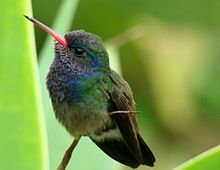- Bee Hummingbird
-
Bee Hummingbird 
Conservation status Scientific classification Kingdom: Animalia Phylum: Chordata Class: Aves Order: Trochiliformes Family: Trochilidae Genus: Mellisuga Species: M. helenae Binomial name Mellisuga helenae
(Lembeye, 1850)The Bee Hummingbird or Zunzuncito (Mellisuga helenae) is a species of hummingbird that is endemic to Cuba and Isla de la Juventud. With a mass of approximately 1.8 grams (0.063 oz) and a length of 5 centimetres (2.0 in), it is the smallest living bird.
Contents
Description
The male has the green pileum and fiery red throat, iridescent gorget with elongated lateral plumes, bluish upper-parts, and the rest of the underparts mostly greyish white. The male is smaller than the female. The female is green above, whitish below with white tips to the outer tail feathers. Compared to other small hummingbirds, which often have a slender appearance, the Bee Hummingbird looks rounded and chunky.
Female bee hummingbirds are bluish green with a pale gray underside. The tips of their tailfeathers have white spots. Breeding males have a reddish to pink head, chin, and throat. The female lays only two eggs at a time.
As the smallest bird in the world, it is no larger than a big insect and, as its name suggests, is scarcely larger than a bee. Like all hummingbirds, it is a swift, strong flier. It also can hover over one spot like a helicopter. The bee hummingbird beats its wings an estimated 80 times per second — so fast that the wings look like a blur to human eyes.
The brilliant, iridescent colors of the bee hummingbird's feathers make the bird seem like a tiny jewel. The iridescence is not always noticeable, but depends on the angle at which a person looks at the bird. The bird's slender, pointed bill is adapted for probing deep into flowers. The bee hummingbird feeds mainly on nectar, and an occasional insect or spider, by moving its tongue rapidly in and out of its mouth. In the process of feeding, the bird picks up pollen on its bill and head. When it flies from flower to flower, it transfers the pollen. In this way, it plays an important role in plant reproduction. In the space of one day the bee hummingbird may visit 1,500 flowers.[2]
Using bits of cobwebs, bark, and lichen, the female bee hummingbird builds a cup-shaped nest that is only about 1 inch (2.5 cm) in diameter. Nests have been built on single clothespins. She lines the nest with soft plant fibers. In this nest she lays her eggs, which are no bigger than peas. She alone incubates the eggs and raises the young.
References
- ^ BirdLife International (2008). "Mellisuga helenae". IUCN Red List of Threatened Species. Version 2010.4. International Union for Conservation of Nature. http://www.iucnredlist.org/apps/redlist/details/143114. Retrieved 25 April 2011. Database entry includes a brief justification of why this species is near threatened
- ^ Piper, Ross (2007), Extraordinary Animals: An Encyclopedia of Curious and Unusual Animals, Greenwood Press.
See also
- Hummingbird moth
External links
- Bee Hummingbird videos, photos & sounds on the Internet Bird Collection
- Bee Hummingbird Video from birdingcuba.com
- Bee Hummingbird photo gallery VIREO
- Article with synopsis (with photos); Photo
Categories:- IUCN Red List near threatened species
- Mellisuga
- Birds of Cuba
Wikimedia Foundation. 2010.

